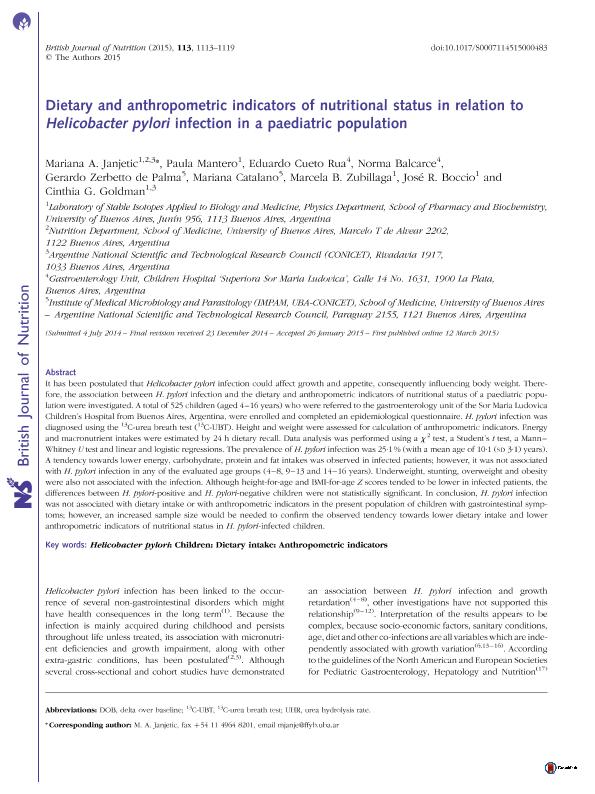Artículo
Dietary and anthropometric indicators of nutritional status in relation to Helicobacter pylori infection in a paediatric population
Janjetic, Mariana Andrea ; Mantero, Paula; Cueto Rua, Eduardo; Balcarce, Norma; Zerbetto de Palma, Gerardo Gabriel
; Mantero, Paula; Cueto Rua, Eduardo; Balcarce, Norma; Zerbetto de Palma, Gerardo Gabriel ; Catalano, Mariana; Zubillaga, Marcela Beatriz
; Catalano, Mariana; Zubillaga, Marcela Beatriz ; Boccio, José R.; Goldman, Cinthia Gabriela
; Boccio, José R.; Goldman, Cinthia Gabriela
 ; Mantero, Paula; Cueto Rua, Eduardo; Balcarce, Norma; Zerbetto de Palma, Gerardo Gabriel
; Mantero, Paula; Cueto Rua, Eduardo; Balcarce, Norma; Zerbetto de Palma, Gerardo Gabriel ; Catalano, Mariana; Zubillaga, Marcela Beatriz
; Catalano, Mariana; Zubillaga, Marcela Beatriz ; Boccio, José R.; Goldman, Cinthia Gabriela
; Boccio, José R.; Goldman, Cinthia Gabriela
Fecha de publicación:
04/2015
Editorial:
Cambridge University Press
Revista:
British Journal of Nutrition
ISSN:
0007-1145
Idioma:
Inglés
Tipo de recurso:
Artículo publicado
Clasificación temática:
Resumen
It has been postulated that Helicobacter pylori infection could affect growth and appetite, consequently influencing body weight. Therefore, the association between H. pylori infection and the dietary and anthropometric indicators of nutritional status of a paediatric population were investigated. A total of 525 children (aged 4-16 years) who were referred to the gastroenterology unit of the Sor Maria Ludovica Children's Hospital from Buenos Aires, Argentina, were enrolled and completed an epidemiological questionnaire. H. pylori infection was diagnosed using the 13C-urea breath test (13C-UBT). Height and weight were assessed for calculation of anthropometric indicators. Energy and macronutrient intakes were estimated by 24 h dietary recall. Data analysis was performed using a χtest, a Student's t test, a Mann-Whitney U test and linear and logistic regressions. The prevalence of H. pylori infection was 25·1 % (with a mean age of 10·1 (sd 3·1) years). A tendency towards lower energy, carbohydrate, protein and fat intakes was observed in infected patients; however, it was not associated with H. pylori infection in any of the evaluated age groups (4-8, 9-13 and 14-16 years). Underweight, stunting, overweight and obesity were also not associated with the infection. Although height-for-age and BMI-for-age Z scores tended to be lower in infected patients, the differences between H. pylori-positive and H. pylori-negative children were not statistically significant. In conclusion, H. pylori infection was not associated with dietary intake or with anthropometric indicators in the present population of children with gastrointestinal symptoms; however, an increased sample size would be needed to confirm the observed tendency towards lower dietary intake and lower anthropometric indicators of nutritional status in H. pylori-infected children.
Palabras clave:
ANTHROPOMETRIC INDICATORS
,
CHILDREN
,
DIETARY INTAKE
,
HELICOBACTER PYLORI
Archivos asociados
Licencia
Identificadores
Colecciones
Articulos(IMPAM)
Articulos de INSTITUTO DE INVESTIGACIONES EN MICROBIOLOGIA Y PARASITOLOGIA MEDICA
Articulos de INSTITUTO DE INVESTIGACIONES EN MICROBIOLOGIA Y PARASITOLOGIA MEDICA
Articulos(OCA HOUSSAY)
Articulos de OFICINA DE COORDINACION ADMINISTRATIVA HOUSSAY
Articulos de OFICINA DE COORDINACION ADMINISTRATIVA HOUSSAY
Citación
Janjetic, Mariana Andrea; Mantero, Paula; Cueto Rua, Eduardo; Balcarce, Norma; Zerbetto de Palma, Gerardo Gabriel; et al.; Dietary and anthropometric indicators of nutritional status in relation to Helicobacter pylori infection in a paediatric population; Cambridge University Press; British Journal of Nutrition; 113; 7; 4-2015; 1113-1119
Compartir
Altmétricas



